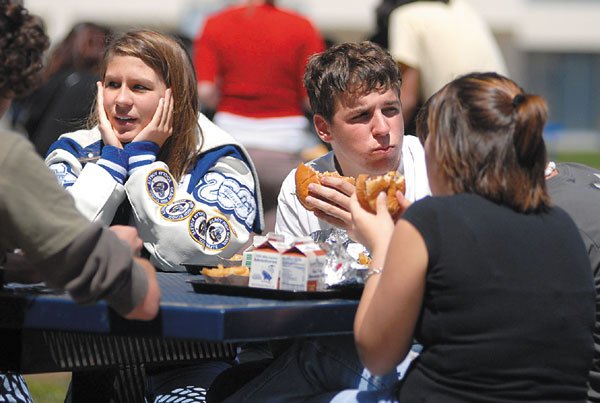Gilroy
– At 2:53pm, when the final bell rings at Gilroy High School,
some students are walking out of the gates having only downed a
piece of fruit and Starbucks nonfat latte the entire day.
Gilroy – At 2:53 pm, when the final bell rings at Gilroy High School, some students are walking out of the gates having only downed a piece of fruit and Starbucks nonfat latte the entire day.
These students are eating next to nothing all day since “Starbucks doesn’t count as eating,” said senior Michael McGarry.
Sodexho – the company that operates the meal service at Gilroy High School – reported that they serve only about 1,000 lunches each day to a population of more than 2,400 high school students – a service rate of 42 percent. As few students bring their lunch, more than half of the high school population is returning to classes hungry and distracted, said trustee Jaime Rosso.
This is a problem “if our purpose is to promote learning and academic achievement,” he said. “If you’re hungry or you’re not eating properly, you’re obviously not as focused about learning.”
Where’s the Beef?
While administrators and district officials agree this is a problem, the reason why students are not eating is unclear.
Students are going hungry by choice, said Mary Ann Boylan, assistant principal of the high school. She pointed out that there is no line at the food service stations or carts as early as 10 minutes before the end of the 33-minute lunch period.
By that time, it’s too late, said junior Stina Marshall.
“If you don’t have a class where you can finish your food, you have to throw half away,” she said.
She and fellow junior Katey Creswell on occasion skip lunch – and the 10- to 15-minute line that comes with it – so this does not happen.
“Sometimes we’ll wind up just getting chips from the vending machine,” Marshall said.
“Just to hold us off until we get home and we can get real food,” finished Creswell.
The Lunchtime Pressure Cooker
If the high school managed to convince its students to eat, it would not be able to serve them all, said Rosso.
“By design, half our kids will not get lunch,” he said.
The time allotted to serve students is too small to cover everyone, said Steve Brinkman, assistant superintendent of business services for the Gilroy Unified School District. This comes despite the best efforts of Sodexho, said Alane Webb, district director of food services. In addition to the main cafeteria in the student center, the high school has two carts on the opposite side of the quad and will have five carts next academic year.
To increase the time allotted to serve students lunch, the operations office of the district has advocated a split schedule, whereby two sections of students would be released to eat lunch at different times, said Brinkman.
A split lunch would be a disaster, said James Maxwell, the high school principal. If participants have different lunch schedules, meetings for extra-curricular groups, such as the gay-straight alliance, and between some teachers and students would be disrupted. The ubiquitous handball games would also disappear because there would be classes on the other side of the walls students use to bounce the ball off of.
The issue of a split lunch and having enough time in the lunch period to serve all the students might die down when the new high school comes online in 2009, said Brinkman. Christopher High School is slated to take in 900 students by 2013 and the Gilroy Early College Academy – opening this fall at Gavilan – will take away 400 students from Gilroy High School during the next four years.
All this concern over student populations and the operational capacity of food service is irrelevant, insists Boylan. The issue is that students are choosing not to eat lunch, not that they don’t have the opportunity.
“It’s not like they can’t get it if they want it.”













